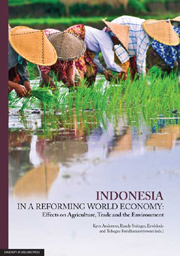Book contents
- Frontmatter
- Contents
- List of tables, figures and boxes
- FIGURES
- Acronyms
- Preface
- List of contributors
- 1 Introduction
- 2 Effects of growth, its interruption, and the Uruguay Round on Indonesian agriculture
- 3 Effects of AFTA and APEC trade policy reforms on Indonesian agriculture
- 4 Trade liberalisation and soil degradation in Indonesia
- 5 Will the Uruguay Round and APEC reforms harm air and water quality in Indonesia?
- 6 Impacts of agricultural protection growth at home and the WTO's Doha Round on Indonesian agriculture
- 7 Effects of agricultural policy reform on household and regional income distribution in Indonesia
- 8 Effects of farm policy reform on Indonesia's secondary food crops
- 9 Effects of agricultural policy reform in Indonesia on its food security and environment
- 10 Impacts of trade policy reform on income distribution and poverty in Indonesia
- APPENDIX 1 The WAYANG Model of the Indonesian economy
- APPENDIX 2 The GTAP Model and database
7 - Effects of agricultural policy reform on household and regional income distribution in Indonesia
Published online by Cambridge University Press: 05 June 2012
- Frontmatter
- Contents
- List of tables, figures and boxes
- FIGURES
- Acronyms
- Preface
- List of contributors
- 1 Introduction
- 2 Effects of growth, its interruption, and the Uruguay Round on Indonesian agriculture
- 3 Effects of AFTA and APEC trade policy reforms on Indonesian agriculture
- 4 Trade liberalisation and soil degradation in Indonesia
- 5 Will the Uruguay Round and APEC reforms harm air and water quality in Indonesia?
- 6 Impacts of agricultural protection growth at home and the WTO's Doha Round on Indonesian agriculture
- 7 Effects of agricultural policy reform on household and regional income distribution in Indonesia
- 8 Effects of farm policy reform on Indonesia's secondary food crops
- 9 Effects of agricultural policy reform in Indonesia on its food security and environment
- 10 Impacts of trade policy reform on income distribution and poverty in Indonesia
- APPENDIX 1 The WAYANG Model of the Indonesian economy
- APPENDIX 2 The GTAP Model and database
Summary
Introduction
The economic crisis of the late 1990s had economic and political consequences which are still unfolding. Within the crisis affected countries, large numbers of rich and poor people were adversely affected. The effects on the poor operated through a contraction in the demand for labour, on the one hand, and increases in commodity prices, especially for internationally traded goods, on the other. These problems have apparently been more severe in Indonesia that anywhere else. Not all poor people in Indonesia were adversely affected. Some smallholder agricultural producers whose products are exported benefited substantially from the depreciation of the national currency, the rupiah. Nevertheless, most poor people, including most agricultural producers, seem to have been harmed, especially those who are net purchasers of food. Food prices have thus been a special concern in the policy response to the crisis.
The staple food of Indonesia, rice, has been a special focus of government intervention for decades. The National Logistics Planning Agency, Bulog, has been charged with regulating food markets, especially rice, and has enjoyed a monopoly in rice imports. One objective of Bulog's interventions in the rice market has been to stabilise domestic rice prices relative to international prices and it has done this effectively (Timmer 1996). Another objective has been to ensure adequate supplies to consumers and this has been reflected in suppression of the average level of domestic prices below the average levels of international prices.
- Type
- Chapter
- Information
- Indonesia in a Reforming World EconomyEffects on Agriculture, Trade and the Environment, pp. 135 - 163Publisher: The University of Adelaide PressPrint publication year: 2009
- 1
- Cited by



